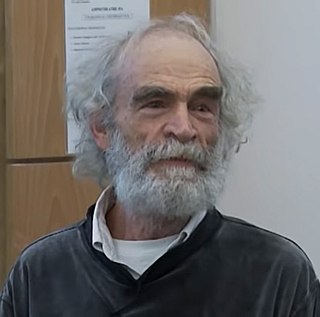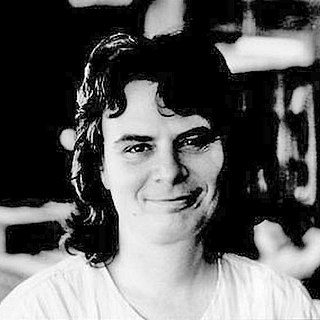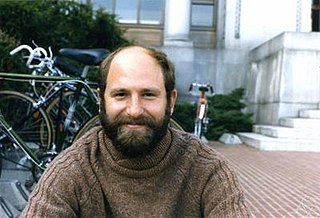Riemannian geometry is the branch of differential geometry that studies Riemannian manifolds, defined as smooth manifolds with a Riemannian metric. This gives, in particular, local notions of angle, length of curves, surface area and volume. From those, some other global quantities can be derived by integrating local contributions.
In mathematics, two linear operators are called isospectral or cospectral if they have the same spectrum. Roughly speaking, they are supposed to have the same sets of eigenvalues, when those are counted with multiplicity.
In mathematics, Gromov–Hausdorff convergence, named after Mikhail Gromov and Felix Hausdorff, is a notion for convergence of metric spaces which is a generalization of Hausdorff convergence.
In mathematics, spectral graph theory is the study of the properties of a graph in relationship to the characteristic polynomial, eigenvalues, and eigenvectors of matrices associated with the graph, such as its adjacency matrix or Laplacian matrix.

Mikhael Leonidovich Gromov is a Russian-French mathematician known for his work in geometry, analysis and group theory. He is a permanent member of Institut des Hautes Études Scientifiques in France and a professor of mathematics at New York University.
In mathematics, the soul theorem is a theorem of Riemannian geometry that largely reduces the study of complete manifolds of non-negative sectional curvature to that of the compact case. Jeff Cheeger and Detlef Gromoll proved the theorem in 1972 by generalizing a 1969 result of Gromoll and Wolfgang Meyer. The related soul conjecture, formulated by Cheeger and Gromoll at that time, was proved twenty years later by Grigori Perelman.

To hear the shape of a drum is to infer information about the shape of the drumhead from the sound it makes, i.e., from the list of overtones, via the use of mathematical theory.

Dusa McDuff FRS CorrFRSE is an English mathematician who works on symplectic geometry. She was the first recipient of the Ruth Lyttle Satter Prize in Mathematics, was a Noether Lecturer, and is a Fellow of the Royal Society. She is currently the Helen Lyttle Kimmel '42 Professor of Mathematics at Barnard College.

Karen Keskulla Uhlenbeck ForMemRS is an American mathematician and one of the founders of modern geometric analysis. She is a professor emeritus of mathematics at the University of Texas at Austin, where she held the Sid W. Richardson Foundation Regents Chair. She is currently a distinguished visiting professor at the Institute for Advanced Study and a visiting senior research scholar at Princeton University.
Joan Sylvia Lyttle Birman is an American mathematician, specializing in low-dimensional topology. She has made contributions to the study of knots, 3-manifolds, mapping class groups of surfaces, geometric group theory, contact structures and dynamical systems. Birman is research professor emerita at Barnard College, Columbia University, where she has been since 1973.

Linda Jo Goldway Keen is an American mathematician and a fellow of the American Mathematical Society. Since 1965, she has been a professor in the Department of Mathematics and Computer Science at Lehman College of the City University of New York and a Professor of Mathematics at Graduate Center of the City University of New York.

Chuu-Lian Terng is a Taiwanese-American mathematician. Her research areas are differential geometry and integrable systems, with particular interests in completely integrable Hamiltonian partial differential equations and their relations to differential geometry, the geometry and topology of submanifolds in symmetric spaces, and the geometry of isometric actions.
Spectral geometry is a field in mathematics which concerns relationships between geometric structures of manifolds and spectra of canonically defined differential operators. The case of the Laplace–Beltrami operator on a closed Riemannian manifold has been most intensively studied, although other Laplace operators in differential geometry have also been examined. The field concerns itself with two kinds of questions: direct problems and inverse problems.

Toshikazu Sunada is a Japanese mathematician and author of many books and essays on mathematics and mathematical sciences. He is professor emeritus of both Meiji University and Tohoku University. He is also distinguished professor of emeritus at Meiji in recognition of achievement over the course of an academic career. Before he joined Meiji University in 2003, he was professor of mathematics at Nagoya University (1988–1991), at the University of Tokyo (1991–1993), and at Tohoku University (1993–2003). Sunada was involved in the creation of the School of Interdisciplinary Mathematical Sciences at Meiji University and is its first dean (2013–2017). Since 2019, he is President of Mathematics Education Society of Japan.

Richard Lawrence Bishop was an American mathematician who specialized in differential geometry and taught at the University of Illinois at Urbana–Champaign.
Christina Sormani is a professor of mathematics at City University of New York affiliated with Lehman College and the CUNY Graduate Center. She is known for her research in Riemannian geometry, metric geometry, and Ricci curvature, as well as her work on the notion of intrinsic flat distance.

Scott A. Wolpert is an American mathematician specializing in geometry. He is a professor at the University of Maryland.
Nancy Burgess Hingston is a mathematician working in differential geometry. She is a professor emerita of mathematics at The College of New Jersey.

Steven Morris Zelditch was an American mathematician, specializing in global analysis, complex geometry, and mathematical physics.
Jürg Peter Buser, known as Peter Buser, is a Swiss mathematician, specializing in differential geometry and global analysis.











